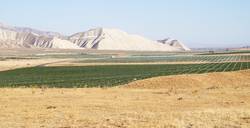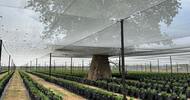
On a former cattle ranch in California's Cuyama Valley, Harvard drilled a dozen water wells and planted a vineyard. Its green vines contrast with the dry fields around it. (Photo: RUSSELL GOLD/THE WALL STREET JOURNAL)
Harvard quietly amasses California vineyards—and the water underneath
SHANDON, Calif.—Steve Sinton, a rancher, was baffled when a company he’d never heard of began buying large tracts of agricultural land near his pastures at above-market prices. The firm, Brodiaea Inc., over a few months in 2012 acquired more than three square miles of a flat-bottomed valley.
“It was surprising, the prices they were willing to pay,” says Mr. Sinton, a partner in a family-owned ranch that raises cattle and grows grapes. A conventional agricultural business’s returns couldn’t have justified those prices. “It didn’t make sense to me.”
Brodiaea’s drilling permits and property purchases were signed by Matt Turrentine, a local who had recently left his family’s grape-brokerage business. He wouldn’t say who was behind the investment, Mr. Sinton and other locals say. The firm bought more acreage, drilled deep-water wells and began planting vineyards capable of producing billions of grapes annually.
One thing was clear. Brodiaea was willing to pay a premium for land that had good access to groundwater, an increasingly valuable resource given that aquifer levels elsewhere in San Luis Obispo County had fallen steeply. “We didn’t know who Brodiaea was,” says Sue Luft, a retired environmental engineer who lived nearby, “but we knew it was big money.”
They got the answer in 2014, in a real-estate newsletter article about the buyer. It was Harvard.
The university’s endowment manager, Harvard Management Co., was stealthily building a sizable grape-growing business on the Central Coast through entities including Brodiaea. With the land, it was acquiring rights to vast sources of water in a region where the earth’s warming is making the resource an ever-more-valuable asset.
Drought has plagued California in recent years, hitting farmers particularly hard. The Central Coast experienced drought conditions for 30% of the past two decades, compared with 14% of the prior 100 years, a 2015 study found. Droughts have led to spikes in withdrawals from aquifers, many of which aren’t recharging as much during rainy season, says study co-author Noah Diffenbaugh, a Stanford University professor.
Harvard’s bet has proven prescient. The $39 billion fund, among America’s biggest endowments, now values its vineyards at $305 million, up nearly threefold from in 2013, while its overall natural-resources investments have done poorly.
The wager has also earned backlash from some farmers and other locals who fear Harvard eventually will use up groundwater and unduly influence water-use regulations. “Should they be controlling our groundwater plans?” says Debbie Arnold, a San Luis Obispo County supervisor. “I don’t think so.”
Others, like Mr. Sinton, are less concerned, pointing out that some earlier crops were thirstier than grapes. “When I was a kid,” Mr. Sinton says, “they were growing alfalfa and sugar beets there.”
A Harvard Management spokesman says it is the endowment’s policy not to discuss individual investments. In its financial report issued in 2012, the year Brodiaea began buying, Harvard said it liked the natural-resources asset class “because we believe its physical products are going to be in increasing demand in the global economy over the coming decades.”
In a warming planet, few resources will be more affected than water, as more-frequent droughts, storms and changes in evaporation alter a flow critical for drinking, farming and industry.
Even though there aren’t many ways to make financial investments in water, investors are starting to place bets. Buying arable land with access to it is one way. In California’s Central Coast, “the best property with the best water will sell for record-breaking prices,” says JoAnn Wall, a real-estate appraiser who specializes in vineyards, “and properties without adequate water will suffer in value.”
Investors who see agriculture as a proxy for betting on water include Michael Burry, a hedge-fund investor whose wager against the U.S. housing market was chronicled in the book and movie “The Big Short.” In a 2015 New York Magazine interview, Mr. Burry was quoted as saying: “What became clear to me is that food is the way to invest in water. That is, grow food in water-rich areas and transport it for sale in water-poor areas.” Mr. Burry declined to comment.
David Gladstone, chief executive of Gladstone Land Corp. , a publicly traded farmland-investment trust, says the recent California drought was profitable for his company and tenant farmers because they had access to water while others didn’t. The changing climate has made control of water more valuable, he says. “That is certainly true in most of the U.S., but very true in California.”
In California vineyards, the water-proxy math is compelling. When grapes are harvested, about 75% of their weight is water. California’s wine is a globally coveted product, so owning vineyards effectively turns water into revenue.
“You can’t farm without water. Period,” says Madeleine Fairbairn, an assistant professor at University of California Santa Cruz who studies the phenomenon of investors buying farmland. “California land values are therefore very linked to water rights.”
Water has long been contentious in California. Los Angeles used subterfuge to acquire water rights from the Owens Valley, a deal that helped inspire the movie “Chinatown.” More recently, farm irrigation has raised concern among some environmentalists who argue that crops such as almonds use excessive water.
Climate change is making the situation worse, scientists and state officials say. The Sierra Nevada snowmelt that satiates much of the state has become harder to count on,sometimes coming earlier in the season and overwhelming the capacity of reservoirs to contain it before it goes to sea—or barely coming at all.
A year before Harvard began acquiring property, local officials began worrying about declines in the region’s groundwater basin. It was once celebrated as one of the largest freshwater aquifers west of the Mississippi River, but the level in certain wells had fallen significantly.
In early 2011, San Luis Obispo County issued a report with a map showing in deep red—a “red zone” or “red spot,” locals call it—where groundwater had fallen more than 70 feet. “We’re having more heat and more drought,” says Willy Cunha, a vineyard manager in the county. That has put a premium on land with good water, he says. “It is like California beachfront property. God isn’t making any more of it.”
There are no tourist markers or plush tasting rooms at Harvard’s vineyards, just “no trespassing” signs, rutted roads and farming equipment. Harvard Management’s agricultural operation sells grapes to winemakers.
Harvard’s foray harks back to 2012, when Mr. Turrentine and James Ontiveros, a local vineyard manager, founded an agricultural investment advisory firm named Grapevine Capital Partners LLC and pitched the idea to Harvard. Harvard signed on.
Grapevine Capital “identified an area where the groundwater is very good, and it’s outside the red zone,” says Tony Correia, an agricultural-land appraiser specializing in vineyards. Wine-industry writer Rusty Gaffney wrote in 2015 that Mr. Ontiveros had spoken to him of the land Grapevine steered Harvard toward, telling him “the region had sufficient underground water aquifers to be successfully farmed despite recent climate changes and drought conditions.”
Mr. Turrentine says he doesn’t have permission from Harvard to discuss the investments. Mr. Ontiveros didn’t respond to requests for comment.
The land Grapevine identified for Harvard was in a flat-bottomed valley south of Shandon, 190 miles northwest of Los Angeles, county records show. The groundwater in this area was much easier to tap than in other grape-growing operations that form the heart of the Paso Robles wine region, according to reports from the local groundwater agency. It was relatively close to the surface and had fallen less than 30 feet.
In addition, a giant aqueduct passed through the valley on its way to Santa Barbara. Local officials had negotiated rights to tap into it.
In June 2012, Mr. Turrentine filed paperwork to create Brodiaea—the scientific name for a type of lily—which was wholly owned by Harvard, although those filings didn’t show that. In July, Brodiaea bought its first property in the county. It generally bought unlisted properties, many of them carrot farms, local brokers say.
By autumn, Brodiaea had pieced together about 3,000 acres, county records show, and started to plant vineyards. The firm eventually became one of San Luis Obispo County’s 10 largest property owners by taxable value.
In the summer of 2013, several residential wells ran dry between Paso Robles and Shandon, roughly 10 miles west of Harvard’s vineyards. The general consensus was that the drought led vineyards to pump more well water. Residents began attending county meetings demanding action in the groundwater basin, which included Harvard’s land.
Local resident Lindsay Pera told elected officials at a county meeting in July 2013 that her home was surrounded by green vineyards and “that green is the water we are trucking, from our ground, out of the county in the form of wine.” She says she still worries about the large-scale extraction of water from the Paso Robles basin.
The county supervisors issued an emergency moratorium on new agricultural wells starting Aug. 27, 2013—not just wells in the affected areas but also in areas such as Harvard’s holdings where groundwater hadn’t fallen as much.
The day before the moratorium took effect, Harvard’s Brodiaea filed for permits to drill seven wells deeper than anything else in that part of the county—enough to fill an Olympic-size swimming pool in 90 minutes. One well hit water at 112 feet, but the driller completed the well to 1,200 feet deep, county records show.
This would allow it to keep drawing water, even if droughts dropped the groundwater level further.
About four months later, Harvard filed paperwork to create a new entity, SLO San Juan Road LLC. Messrs. Turrentine and Ontiveros’s firm, Grapevine, acted as the agent for the new entity. Through SLO, Harvard continued buying property south of Shandon. In early 2014, Brodiaea bought an 8,700-acre cattle ranch in the nearby Cuyama Valley.
Harvard’s firms continued to plant rootstock on its Shandon-area properties. Its new vines would soon carpet most of the valley.
In March 2014, the Farmland Investor Letter revealed that Harvard was backing Brodiaea. Some local residents were vocally upset, saying that Harvard and Mr. Turrentine were positioning themselves to have an outsize influence on the future of groundwater use, leaving smaller rural residents without a voice.
In early 2016, rigs hired by Brodiaea began to drill 12 water wells on its Cuyama Valley property. When they were done, workers began to plant vines there as well, pumping up aquifer water to nourish the new plants.
Cindy Steinbeck is a vineyard owner whose family had grown grapes in the area for five decades. She wrote to Harvard Management’s president in March 2016 saying its use of limited-liability companies “seems designed to obfuscate Harvard’s activities in the area.”
“Such an investment does not make economic sense,” she wrote, noting above-market prices Harvard was paying, “if your intent is simply to grow and sell grapes. It would, however, make perfect sense if the investment wasn’t for farming but rather for the brokering of water.”
A Harvard official responded that its investment was “purely agricultural in nature” and that the vineyards prioritized water conservation. She says she remains concerned.
Kat Taylor, an environmentalist and wife of hedge-fund billionaire and liberal activist Tom Steyer, resigned earlier this year from Harvard’s board of overseers in protest of the endowment’s investments in things such as fossil fuels and water holdings she says threaten the human right to water. The board helps run the university but doesn’t have direct responsibility for the management company.
“It may, in the short run, be about developing vineyard property,” she says of Harvard’s California investments. “In the long run, it was a claim on water.”
Harvard’s investing guidelines say respecting local resource rights are of increasing importance “in the coming decades as competition for scarce resources, such as arable land and water, intensifies due to increasing global population, climate change, and food consumption.” All plans Harvard has filed indicate it intends to use its water to grow grapes.
In 2014, California experienced its warmest year on record. Gov. Jerry Brown, seeking to preserve groundwater, signed sweeping legislation to prevent depletion. The Sustainable Groundwater Management Act identified 20 “critical” basins, including those under Harvard’s vineyards, that needed to develop plans by 2020 to limit groundwater drawdowns.
To help write those water plans, large landowners in Shandon voted in 2017 to create their own water district governed by a five-member committee. Mr. Turrentine was elected to the committee, giving Harvard a voice in the planning.
The groundwater basin in nearby Cuyama Valley was also on the “critical” list. Mr. Turrentine’s Grapevine hired hydrologists to argue to the state that there was a geologic fault separating Harvard’s Cuyama vineyards from the rest of the basin.
So far, the state has disagreed with Harvard’s request to designate a new basin—a designation that would mean it wouldn’t have to compete with some big farms for limited water allotments.
“If they start to pull on what I got,” says Jon Jones, a farmer near the Harvard vineyard, “there’s going to be an issue.”
Roberta Jaffe, who with her husband, Steve Gliessman, runs a small family vineyard and olive orchard nearby, is concerned warming weather is already making water more scarce and valuable. She worries Harvard could seek to send water toward cities in Southern California. As a precedent, she points to Cadiz Inc., a California water-supply company that has obtained county and federal permission to build a pipeline from under the Mojave Desert to sell 16.3 billion gallons a year to coastal cities.
“The most unimaginable things can happen,” she says.
Harvard has applied to build three large lined reservoirs on its Cuyama Valley vineyard and is waiting to hear from county officials. Each could hold 16 million gallons. Ms. Jaffe and others have argued against it.
At a meeting this autumn of the local planning commission, Brodiaea consultant David Swenk said the company was within its rights to develop the water resources. “A farmer has a right to farm,” he said, “and can utilize the water under their property.”













